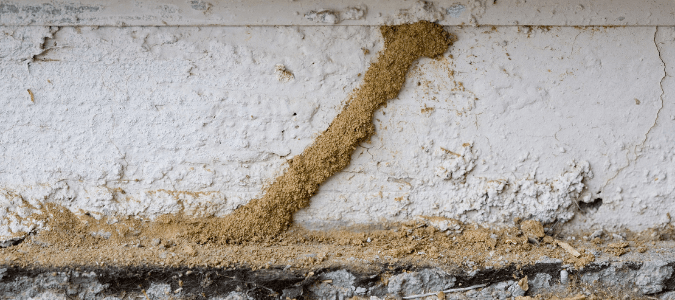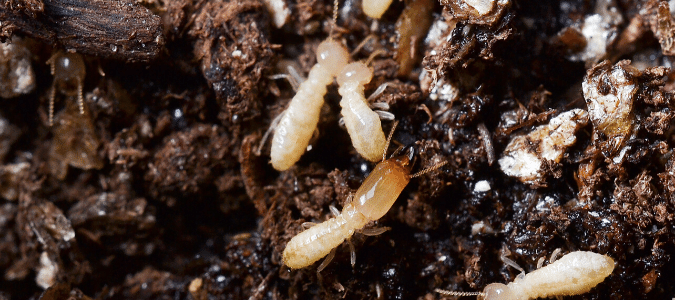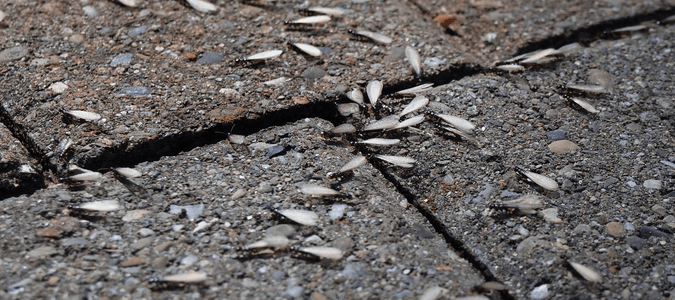How To Identify Subterranean Termite Tubes

A termite infestation is every homeowner’s nightmare, as these annoying wood-eating pests can cause significant structural damage. The good news is that there is one way to spot a termite infestation: termite tubes.
Termite tubes, or tunnels, are structures that termites build to travel between their shelter and their food source. If you know what to look for, you might find them around your home’s foundation before seeing an actual termite.
How To Identify Subterranean Termite Tubes
One sign of a termite infestation on your property is finding termite tubes. Worker termites build termite tubes and tunnels for shelter and to maintain a moist environment. They build them with soil, wood and bits of debris, and the tubes allow termites to move between soil and their food source. Since termite tubes are a sign of an infestation, it’s important for homeowners to know what they look like.
Termite tubes have a mud-like appearance, and their size varies based on the needs of the termite colony. For example, thin termite tubes resemble the shape and size of a pencil. Larger termite tubes can be as thick as a thumb.
The size of the termite tube is based on the colony’s size. If you notice large and thick termite tubes on your property, that likely means that the termite colony taking up residence is quite large.
No matter what size termite tubes you notice, dealing with a termite infestation as quickly as you can is important. Do not wait for the tubes to get bigger before you contact a pest control service.
The appearance of termite tubes also varies based on how old they are and how long the termite colony has been around. Older termite tubes will start to look broken and dirty as they accumulate debris and dirt. The less pristine a termite tube looks, the longer it has been there.
Next, it’s important for homeowners to understand where termite tubes are most likely to be located on their property. Regular inspections of these areas can help homeowners catch termite infestations earlier.
Worker termites build tubes both indoors and outdoors. However, they typically start on the ground. They will extend from the ground towards their food source. Homeowners may also see outdoor termite tubes around their home’s foundation and the house’s structure.
Inside the home, termites build along the surface of walls, floors and other wooden structures. In fact, they use termite tubes and tunnels to bridge the gap between soil and wooden elements inside the home. It’s important for homeowners to inspect their basements, crawl spaces and other wooden structures.
Termites are invasive pests that can cause significant damage to a home. It’s important to control them as soon as possible to minimize all potential damage, and the best way to control termites is by working with a pest control professional.

What Do Subterranean Termites Look Like?
In order to catch an infestation before it goes too far, it’s wise for homeowners to understand what subterranean termites look like. Each subterranean termite colony has three types of termites in their caste system: reproductive termites, worker termites and soldier termites.
The appearance of termites changes slightly based on their position in the caste. However, most subterranean termites are a pale yellow-brown color.
The reproductive termites are more noticeable than the other members of their colony because they are the only ones with wings. They have two pairs of translucent wings that are equal in size and shape.
Reproductive termites are also larger than the other caste members. They measure around a half inch to one inch in length. More information about reproductive termites is in the next section.
Next, worker termites are often the same color as reproductive termites; however, they are the smallest in size in the caste. Worker termites measure around one-eighth of an inch long, and they do not have wings.
Worker termites have many responsibilities. They must feed the colony, care for the young and build the termite tubes.
Lastly, soldier termites are larger than workers but smaller than reproductive termites. They measure around a quarter of an inch long. Their coloring often matches the rest of the colony; however, they may also appear paler than the other termites.
Soldier termites defend the colony from outside threats. They have large, dark heads that have strong jaws, or mandibles, that they use to defend themselves. Their mandibles set them apart from the other members of the termite colony. Like worker termites, they do not have wings.
When soldier termites sense a threat, they use their large heads to bang into the surrounding walls to send vibrational messages to the worker and reproductive termites.
How to Deter Subterranean Termites
As a homeowner, it’s normal to want to take matters into your own hands to deter a termite infestation. While there are some at-home methods you can try, the best way to control a termite infestation is to work with a professional.
Expert pest control services can use the best tools and prevention methods to reduce your chances of a termite infestation in your yard and home. However, you can practice these do-it-yourself methods to complement professional services:
- Minimize wood-to-soil contact by keeping firewood, lumber and mulch away from your home’s foundation.
- Maintain proper ventilation in your crawl spaces to reduce termite-attracting moisture.
- Seal cracks and openings that could give termites easy access to your home.
- Conduct regular inspections for termite activity, especially around the wooden structures of your home.

Everything Homeowners Need to Know About Winged Subterranean Termites
The only termites that have wings are reproductive termites, which are also known as alates or swarmers. It is their job to leave their colonies, mate and start new colonies.
In the spring or early summer, winged termites leave their colonies and go on a “mating flight.” The mating flight happens in the spring or summer because termites prefer warm and humid weather. It’s common for them to take flight after a rain shower.
During the mating flight, male and female termites swarm together and partner up to reproduce. After mating, both male and female termites shed their wings and start the new colony. Termites are different from other pests in that the males continue to live after mating.
The female reproductive termite becomes the queen of the new colony. Under ideal conditions, a female can lay up to one thousand eggs a year.
Spotting Winged Termites in Your Home
Winged termites are often the first termites that homeowners notice in their homes. This is due to the mating flight that brings the termites above ground. This is often referred to as a termite swarm. Meanwhile, worker and soldier termites spend most of their lives out of sight.
During the termite swarm, the reproductives will leave the underground colony. If the termite swarm happens in a home, you will see the termites flying toward light sources, such as light fixtures or windows. Since termites shed their wings after mating, it’s also common to spot discarded wings around window sills, doors and other areas where they swarmed.
It’s important to remember that spotting swarming termites is a strong indication that a full termite colony is nearby. It is likely that the colony is advanced, which means they could already be causing significant structural damage to your home.
As soon as you spot swarming termites, the first thing you need to do is contact a pest control service. The professionals can control the colony for you and offer services to help prevent future infestations.
Control Termites With Professional Assistance
A termite infestation is a serious problem for homeowners that must be addressed promptly and correctly. The best way to do so is to work with a professional pest control service. The experts will use the best methods and tools to kick termites out of your home.
Do not wait to contact a professional as soon as you suspect a termite infestation. The sooner you take care of the problem, the less damage termites can cause in your home.
Chem-Free Can Handle Your Termite Problems
Due to the potential damage termites can bring to your home, the best route to take is to contact a reliable pest control specialist. The professionals at Chem-free will be able to locate the termite colony residing in or near your home. They will create a termite treatment plan for your property. They can also advise you on identifying the noises that termites make.

